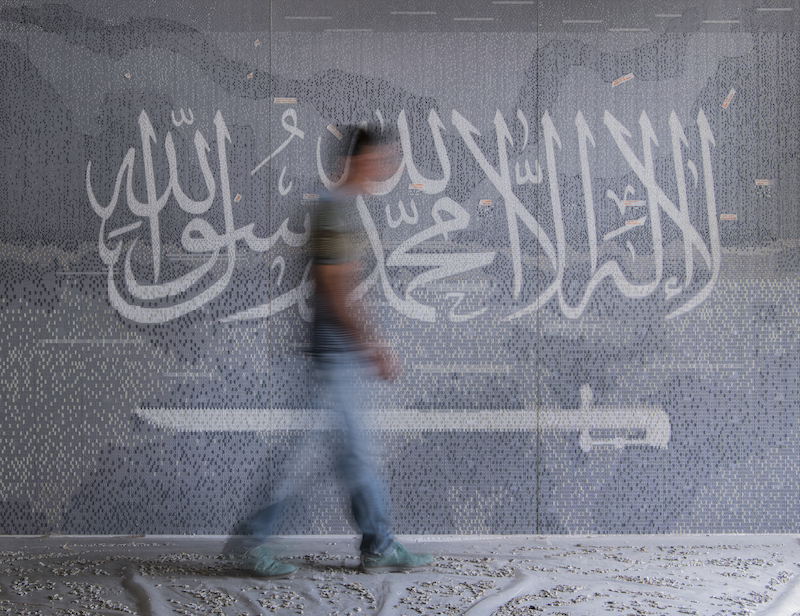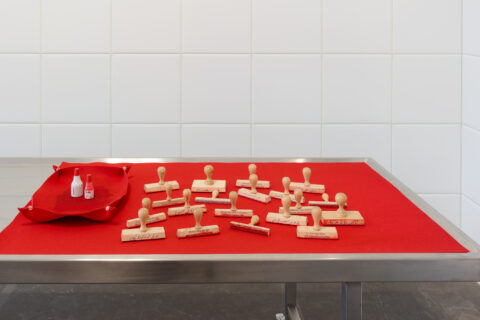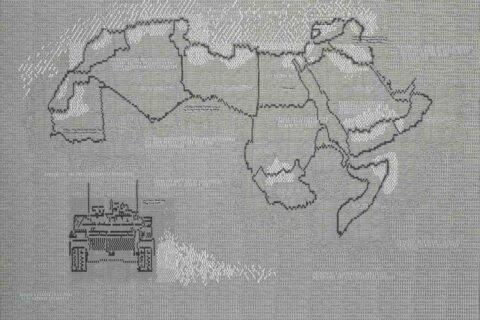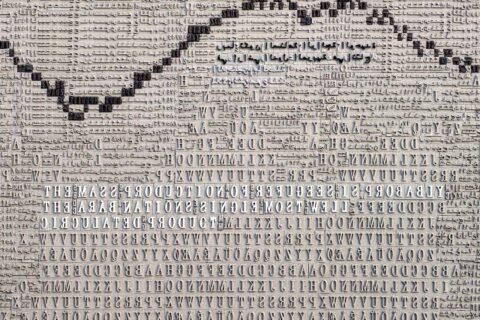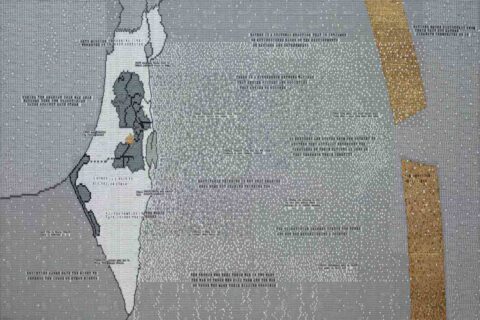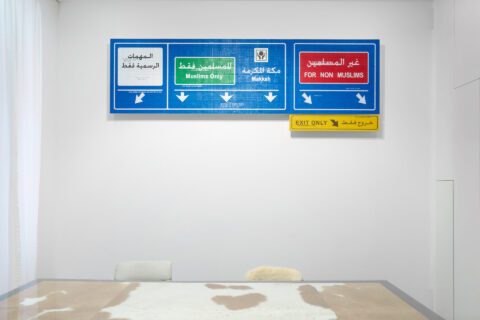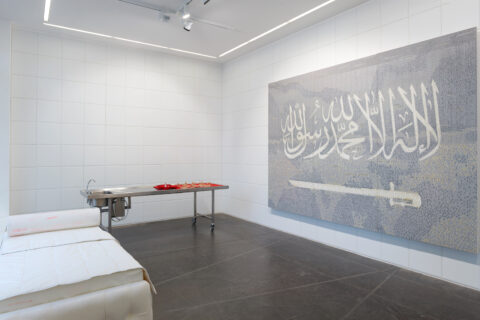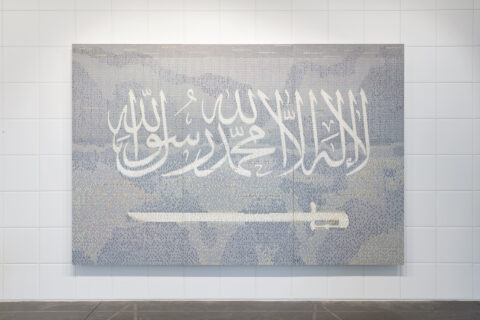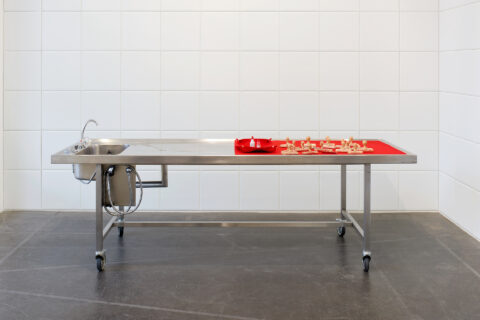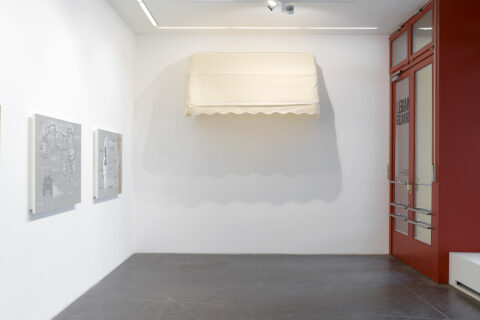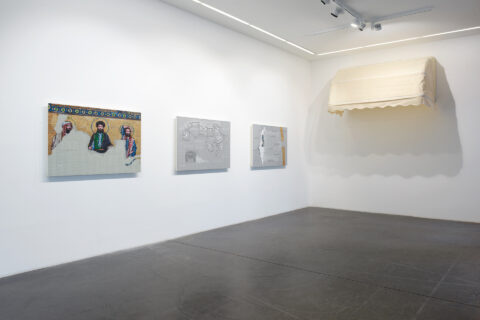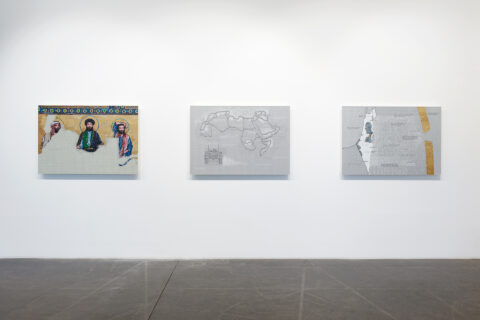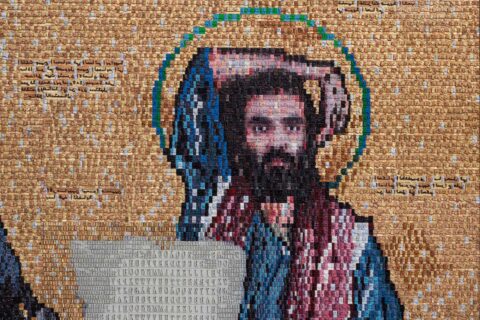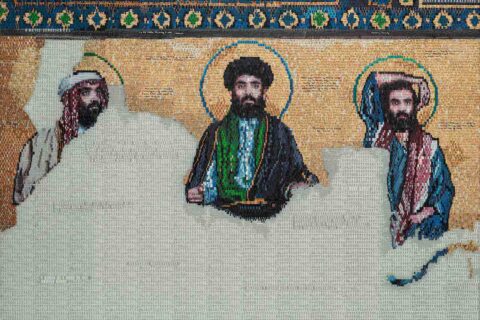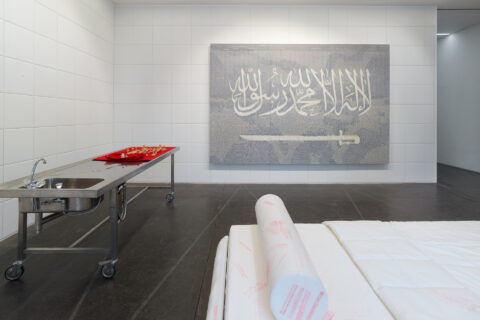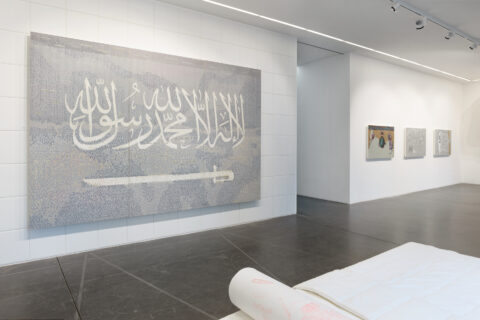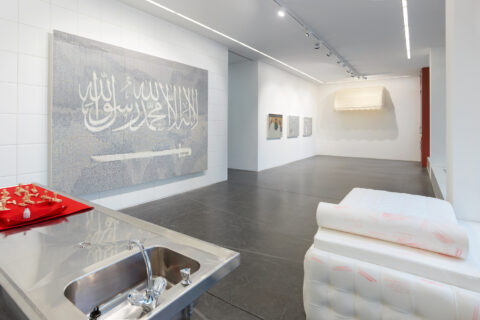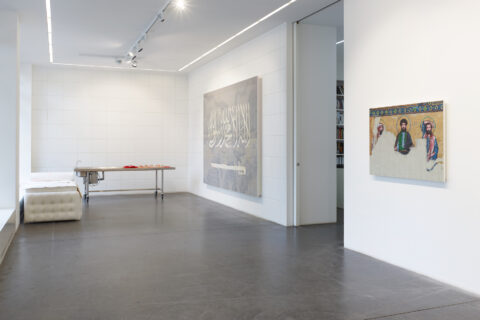Abdulnasser Gharem Smart Obedience / Kluger Gehorsam
12/09/2020 – 01/11/2020
Galerie Nagel Draxler
Weydingerstr. 2/4
10178 Berlin
Eröffnung: Freitag, 11. Sept., 12–21 Uhr
Opening: Friday, Sept. 11th, 12–9 pm
Öffnungszeiten / Hours:
Dienstag bis Samstag, 11-18 Uhr (ausgenommen sind Feiertage)
Tuesday to Saturday, 11am-6pm (excluding public holidays)
und nach Vereinbarung / and by appointment: berlin@nagel-draxler.de
Verlängerte Öffnungszeiten / extended opening hours:
Samstag, 12. Sept. & Sonntag, 13. Sept.: 12–19 Uhr
Saturday, Sept. 12th & Sunday, Sept. 13th: 12–7 pm
Smart Obedience, 2019
Galerie Nagel Draxler, Berlin 2020
Smart Obedience, 2019
Galerie Nagel Draxler, Berlin 2020
The Safe, 2019
„Smart Obedience / Kluger Gehorsam“
Installation view
Galerie Nagel Draxler, Berlin 2020
Photo: Simon Vogel
Personal Holocaust, 2020
„Smart Obedience / Kluger Gehorsam“
Installation view
Galerie Nagel Draxler, Berlin 2020
Personal Holocaust, 2020
„Smart Obedience / Kluger Gehorsam“
Installation view
Galerie Nagel Draxler, Berlin 2020
Hospitable Thinking, 2020
„Smart Obedience / Kluger Gehorsam“
Installation view
Galerie Nagel Draxler, Berlin 2020
Hospitable Thinking, 2020
„Smart Obedience / Kluger Gehorsam“
Installation view
Galerie Nagel Draxler, Berlin 2020
Road to Makkah, 2019
„Smart Obedience / Kluger Gehorsam“
Installation view
Galerie Nagel Draxler, Berlin 2020
Photo: Simon Vogel
The Safe, 2019
„Smart Obedience / Kluger Gehorsam“
Installation view
Galerie Nagel Draxler, Berlin 2020
Photo: Simon Vogel
The Safe, 2019
„Smart Obedience / Kluger Gehorsam“
Installation view
Galerie Nagel Draxler, Berlin 2020
Photo: Simon Vogel
The Safe, 2019
„Smart Obedience / Kluger Gehorsam“
Installation view
Galerie Nagel Draxler, Berlin 2020
Photo: Simon Vogel
Prosperity without growth II, 2020 (Detail)
„Smart Obedience / Kluger Gehorsam“
Installation view
Galerie Nagel Draxler, Berlin 2020
Prosperity without growth II, 2020 (Detail)
„Smart Obedience / Kluger Gehorsam“
Installation view
Galerie Nagel Draxler, Berlin 2020
„Smart Obedience / Kluger Gehorsam“
Installation view
Galerie Nagel Draxler, Berlin 2020
Photo: Simon Vogel
„Smart Obedience / Kluger Gehorsam“
Installation view
Galerie Nagel Draxler, Berlin 2020
Photo: Simon Vogel
Press Release
SMART OBEDIENCE
by Studio Abdulnasser Gharem, 2020
In the Arab world, policy has suddenly died, and all that remains are schemes to survive. Consequently, the mass production of refugees has become what may be the Arab nations’ single most well-circulated product.
To the countries that enjoy the notion of terrestrial hospitality, the new refugees carry with them a hospitable thinking which accepts not only cohabitation but also joint persuasion.
As a result, the concept of smart obedience has emerged. Arab citizens have turned into national hostages as their citizenship has become solely limited to their being the insurance policy on the lives and permanence of Arab leaders.
After the emergence of adversarial revolutions in the Arab nations, Abdulnasser Gharem noticed the differences in freedom of expression which lead to dire consequences.
In spite of this, some persisted and were able to endure the outcomes. For example, the contemporary act of self-immolation and an individual’s usage of his or her own death as a form of final protest as if it were a (personal holocaust).
Or the accidental extirpation of an individual at the hands of employees, and fragmenting him into pieces in order to dissolve his features.
Abdulnasser Gharem reminds us that freedom of thought is a human right, and a person’s free actions occur primarily in the mind and not in nature. Individuals are transformed into an invisible group because the homeland can contain and only be contained in the mind.
Arab nations are in need of independent thinkers and protestors that can fail but do not err. Their societies have realized that enlightenment comes not from the outside but rather from within. It is actually the movement of an educated level of society that questions its own heritage and daily issues, and relies on epistemic disobedience. This leads to changes and not reforms.
Through the works in this exhibition the stamp paintings rest on the repetition of letters and numbers, which are used in the daily life of an Arab individual.
Abdulnasser Gharem suggests that the myth of the unity of language and religion no longer creates nations, and a nation is no longer a kindred religion or unified language. The artist confirms that Arabism is a fundamental linguistic experiment and not a political ideology.
He also points out that the deliberate repetition is a necessity because there is repetition that binds and repetition that liberates.
PRESS RELEASE
Galerie Nagel Draxler Berlin is pleased to announce Smart Obedience, our first solo exhibition with Saudi artist Abdulnasser Gharem. The exhibition will run from 12 September to 1 November 2020.
Abdulnasser Gharem is widely considered as one of Saudi Arabia’s leading contemporary artists. Born in 1973 near Khamis Mushait, in southern Saudi Arabia, Gharem once was a Lieutenant Colonel in the Saudi Arabian Army. During the 1990s he spent his spare time working at the Al-Meftaha Arts Village, where he moved away from traditional painting and towards a performance-based and conceptually demanding practice. Today Gharem's socio-critical work adopts very subtle forms of critique in order not to play into the hands of a repressive system.
In his work The Safe, Gharem refers to the assassination of journalist Jamal Khashoggi in the Saudi Arabian embassy in Istanbul in 2018. The Safe consists of a cell-like installation with padded walls reminding of psychiatric asylum for violent inmates, and an autopsy table with rubber stamps. Also included is the large scale “painting” Smart Obedience, depicting the Saudi flag in different shades of grey. In Gharem’s artistic practice stamps are both subject and material of his art. His paintings are made from thousands of tiny rubber letters taken from stamps. The works are “infiltrated” with hidden messages, often mirror-written as they would be on a real stamp.
Finally, the eggshell-colored baldachin is a direct visual quote and resembles the one of the entry door to the Saudi Arabian embassy in Istanbul. Media footage from the surveillance camara outside the embassy showed this entrance over and over again, so the baldachin became a widely recognizable object that stands for Khashoggi’s brutal murder.
The two works Hospitable Thinking and Personal Holocaust show maps, they are a look from above on what Abdulnasser Gharem considers the Arab world, as well as a close-up of Israel and Palestine, immediately evoking associations about the Israeli-Palestinian conflict, one of the world’s longest-running and most controversial conflicts.
In Hospitable Thinking Gharem added an incomplete yellow arch, resembling a golden rainbow. He used the same color to highlight the city of Jerusalem. Within the composition Gharem has embedded 26 short quotations formed of stamps and written in reverse. On the left, below the drawn tunnel between Gaza and West Bank, which is part of Donald Trump’s recent “Peace to Prosperity” plan, Gharem makes a reference to Thomas Hobbes sentence “A Human is a wolf to his fellow human”. The structure of society and of a legitimate government is a main topic in both new works.
Prosperity Without Growth II can be seen as a general reflection on cultural identity and the heritage it is based on. In both structure and motif there is a reminiscence to byzantine mosaic. Gharem confronts typical elements as ornaments, the gold ground and the nimbus with the triple portrait of an unknown male model. It is the combination of the Marian typical blue and red robe with a turban or a Keffiyeh which negotiate different clothing traditions and subsequently representations of identity.
Hidden in the deep materiality of the painting are citations in English and Arab like: “Epistemic Disobedience”, “Enlightenment cannot be imposed, it is derived from tradition and moved by intellectuals”, “The Fair tyran” or “Epistemic disobedience must be practiced against false power whether it is a religious authority or a domineering one”.
Abdulnasser Gharem lives and works in Riyadh, Saudi Arabia, where he encourages new artistic talents. Gharem was feted in the magazine Rolling Stone as the “rock star” of Saudi contemporary art. Gharem has exhibited in Europe, the Gulf and the USA, including at Gropius-Bau Berlin, the LACMA, the British Museum, the Victoria and Albert Museum as also on the Venice, Sharjah and Berlin Biennales.
_____________________
Die Galerie Nagel Draxler Berlin freut sich Smart Obedience / Kluger Gehorsam, unsere erste Einzelausstellung mit dem saudischen Künstler Abdulnasser Gharem anzukündigen.
Abdulnasser Gharem gilt als einer der führenden zeitgenössischen Künstler Saudi-Arabiens. Geboren 1973 in der Nähe von Khamis Mushait im Süden Saudi-Arabiens, war Gharem einst Oberstleutnant in der saudi-arabischen Armee. In den 1990er Jahren verbrachte er seine freie Zeit im Künstlerdorf Al-Meftaha, wo er sich von der traditionellen Malerei entfernte und sich hin zu einer performancebasierten und konzeptuellen Praxis entwickelte. Heute nimmt Gharems sozialkritisches Werk eher subtile Formen der Kritik an, um einem repressiven System nicht in die Hände zu spielen.
In seiner Arbeit The Safe bezieht sich Gharem auf die Ermordung des Journalisten Jamal Khashoggi in der saudi-arabischen Botschaft in Istanbul im Jahr 2018. The Safe besteht aus einer zellenartigen Installation mit gepolsterten Wänden, die an psychiatrische Kliniken erinnern. Auf einem Seziertisch liegen Gummistempel und an der Wand hängt das großformatige "Gemälde" Smart Obedience, das die saudische Flagge in verschiedenen Grautönen zeigt. Für Gharem sind Stempel nicht nur Gegenstand, sondern auch Material und Werkstoff seiner Arbeiten. Seine Gemälde bestehen aus unzähligen Gummistempeln, die Gharem in Buchstaben und Zahlen zerlegt und aus ihnen versteckte und zumeist spiegelverkehrte Botschaften formt. Die eierschalenfarbene Markise, ist ein direktes visuelles Zitat der Eingangstür der saudi-arabischen Botschaft in Istanbul. Sie wurde durch die mediale Berichterstattung zu einem wiedererkennbaren Objekt, das mit dem brutalen Mord an Jamal Khashoogi in Verbindung steht.
Die beiden Werke Hospitable Thinking und Personal Holocaust zeigen Landkarten. Sie sind Blicke von oben auf das, was Abdulnasser Gharem als die arabische Welt bezeichnet, und auf eine Nahaufnahme von Israel und Palästina, die Assoziationen zu einem der längsten andauernden und umstrittensten Konflikte der Welt weckt. In Hospitable Thinking fügt Gharem einen unvollständigen gelben Bogen hinzu, der einen goldenen Regenbogen andeutet. Dieselbe Farbe verwendet er, um Jerusalem hervorzuheben. In die Komposition sind 26 Zitate eingebettet, die aus Stempeln bestehen und spiegelverkehrte Botschaften ergeben. Unter dem gestrichelten Tunnel zwischen Gaza und dem Westjordanland, der Teil von Donald Trumps aktuellen "Peace to Prosperity"-Plan ist, zitiert Gharem Thomas Hobbes Satz „Der Mensch ist dem Menschen ein Wolf“. Die Struktur von Gesellschaft, aber auch die Legitimation von Regierungen sind zentrale Themen beider neuer Werke.
Prosperity Without Growth II kann als eine allgemeine Reflexion über kulturelle Identität und ihr zugrunde liegende Traditionen verstanden werden. Sowohl die Struktur als auch das Motiv sind Reminiszenzen an das byzantinische Mosaik. Gharem konfrontiert typische Elemente wie Ornament, Goldgrund oder Heiligenschein mit dem dreifachen Porträt eines unbekannten männlichen arabischen Modells. Es ist die Kombination des für Maria typischen blau-roten Gewandes mit einem Turban oder einem Kufiya, welche es vermögen, unterschiedliche Kleidungstraditionen und damit Repräsentationen von Identität zu verhandeln. Die vielschichtige Materialität des Gemäldes birgt auch hier Zitate in englischer und arabischer Sprache wie: “Epistemic Disobedience”, “Enlightenment cannot be imposed, it is derived from tradition and moved by intellectuals”.
Abdulnasser Gharem lebt und arbeitet in Riad, Saudi-Arabien, wo er neue künstlerische Talente mit seinem Projekt Gharem Studio fördert. Gharem wurde in der Zeitschrift Rolling Stone als "Rockstar" der zeitgenössischen Kunst Saudi-Arabiens gefeiert. Gharem hat bereits in Europa, den Golfstaaten und in den USA ausgestellt, unter anderem im Gropius-Bau Berlin, im LACMA, im British Museum, im Victoria and Albert Museum sowie auf den Biennalen von Venedig, Sharjah und Berlin.
